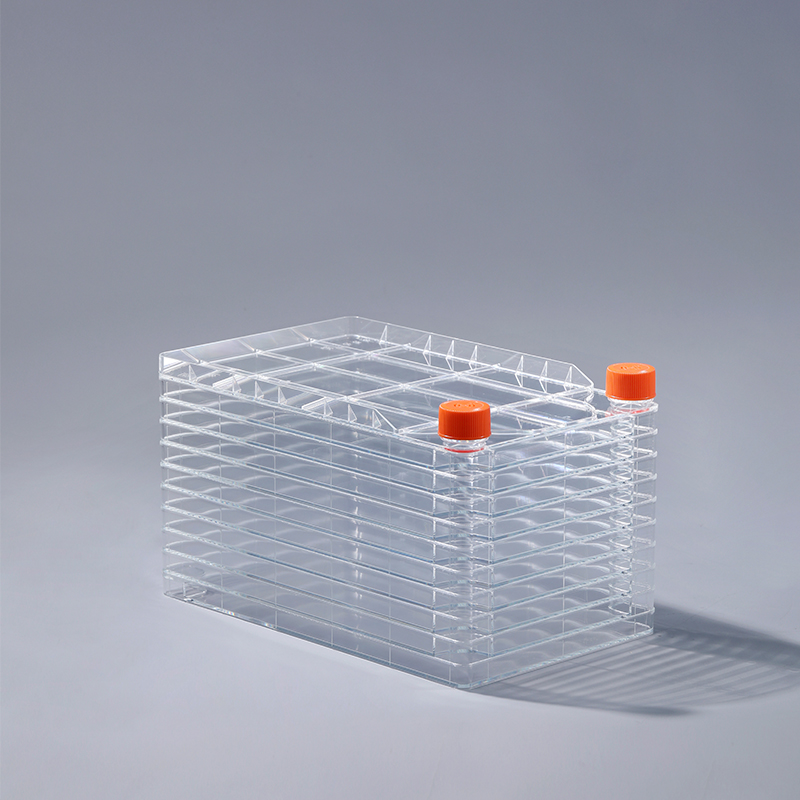เป็นอุปกรณ์เพาะเลี้ยงเซลล์ซึ่งประกอบด้วยชั้นหนึ่งหรือหลายชั้นตามขนาดของพื้นที่เพาะเลี้ยง ซึ่งสามารถรับรู้ถึงการเพาะเลี้ยงเซลล์ในวงกว้าง และเหมาะสำหรับหลายด้าน เช่น วัคซีน อุตสาหกรรมยา หรือโมโนเมอร์โคลนแอนติบอดีโรงงานเซลล์สามารถตอบสนองการเพาะเลี้ยงเซลล์ที่ยึดติด และยังเหมาะสำหรับการเพาะเลี้ยงเซลล์แบบคงที่ของเซลล์แขวนลอย การเพาะเลี้ยงแบบยึดติดหมายความว่าเซลล์จะต้องยึดติดกับผนังของภาชนะเพาะเลี้ยง (ขวด) เมื่อทำการเพาะเลี้ยง เมื่อติดเซลล์แล้ว เซลล์จะแพร่กระจายอย่างรวดเร็ว จากนั้นจึงเริ่มแบ่งเซลล์ และเข้าสู่ระยะการเจริญเติบโตแบบลอการิทึมอย่างรวดเร็ว โดยทั่วไป สองสามวันต่อมา พื้นผิวการเพาะเลี้ยงถูกปกคลุมและเซลล์ชั้นเดียวที่มีความหนาแน่นถูกสร้างขึ้น เช่น เซลล์ Vero, เซลล์ HEK 293, เซลล์ CAR-T, MRC5, เซลล์ CEF, มาโครฟาจถุงอัณฑะ, เซลล์มัยอีโลมา, เซลล์ DF-1, เซลล์ ST, เซลล์ PK15, เซลล์ Marc145 เป็นต้น ล้วนใช้วิธีการเพาะเลี้ยงแบบยึดติดเซลล์โรงงาน
การเพาะเลี้ยงแบบแขวนลอย หมายถึงระบบการเพาะเลี้ยงเนื้อเยื่อที่เพาะเลี้ยงเซลล์เดี่ยวและกลุ่มเซลล์ขนาดเล็กในตัวกลางที่เป็นของเหลวที่มีการกวนหรือเขย่าอย่างต่อเนื่อง การเจริญเติบโตของเซลล์ที่ถูกแขวนลอยไม่ได้ขึ้นอยู่กับพื้นผิวของตัวรองรับ และจะเติบโตในสภาวะที่แขวนลอยในตัวกลางเพาะเลี้ยง ตัวอย่างเช่น เซลล์ CHO เซลล์แมลง เซลล์ BHK21 และเซลล์ MDCK ล้วนใช้ในการเพาะเลี้ยงแบบแขวนลอย
โรงงานผลิตเซลล์ใช้ประโยชน์จากข้อดีของโครงสร้างแบบหลายชั้นและพื้นที่ขนาดใหญ่ และมีการใช้กันอย่างแพร่หลายในการผลิตจำนวนมากเพื่ออุตสาหกรรมเพื่อตอบสนอง ความต้องการสองประการของวัฒนธรรมการยึดมั่นและวัฒนธรรมการแขวนลอย และเป็นที่ชื่นชอบของสถาบันวิจัยทางวิทยาศาสตร์และบริษัทเภสัชกรรมหลายแห่ง
The cell factory utilizes the advantages of multi-layer structure and large area, and is widely used in industrial mass production to meet the dual needs of adherent culture and suspension culture, and is favored by many scientific research institutions and pharmaceutical companies.
The FAI climbed 5.9 percent year-on-year in the first 11 months of 2018, quickening from the 5.7-percent growth in Jan-Oct, the National Bureau of Statistics (NBS) said Friday in an online statement.
The key indicator of investment, dubbed a major growth driver, hit the bottom in August and has since started to rebound steadily.
In the face of emerging economic challenges home and abroad, China has stepped up efforts to stabilize investment, in particular rolling out measures to motivate private investors and channel funds into infrastructure.
Friday's data showed private investment, accounting for more than 60 percent of the total FAI, expanded by a brisk 8.7 percent.
NBS spokesperson Mao Shengyong said funds into weak economic links registered rapid increases as investment in environmental protection and agriculture jumped 42 percent and 12.5 percent respectively, much faster than the average.
In breakdown, investment in high-tech and equipment manufacturing remained vigorous with 16.1-percent and 11.6-percent increases respectively in the first 11 months. Infrastructure investment gained 3.7 percent, staying flat. Investment in property development rose 9.7 percent, also unchanged.
 English
English



















































